Featured Scientist

Author published in"Ophthalmology"affiliate to
Chia-Ying Tsai
School of Medicine,
Fu Jen Catholic University, New Taipei City, Taiwan
Article published in
"Ophthalmology" 2021 Jun;128(6):877-888
Neurodevelopmental Outcomes after Bevacizumab Treatment for Retinopathy of Prematurity: A Meta-analysis
Purpose: To evaluate neurodevelopmental outcomes after intravitreal bevacizumab (IVB) therapy in retinopathy of prematurity (ROP) infants compared with those not exposed to IVB.
Clinical relevance: The primary concern regarding IVB treatment of ROP is the potential systemic side effects, especially the risk of causing severe neurodevelopmental impairment (sNDI). Results regarding neurodevelopmental outcomes after IVB therapy are conflicting.
Methods: We conducted a meta-analysis and searched PubMed, Embase, and Web of Science for related publications from inception through March 12, 2020. The eligibility criteria were as follows: comparative studies of ROP patients that (1) included IVB as a treatment arm, (2) included a control group without bevacizumab treatment, and (3) reported on at least 1 neurodevelopmental outcome, such as sNDI, Bayley Scales of Infant and Toddler Development, Third Edition (Bayley III), composition scores, or cerebral palsy (CP). The primary outcome was sNDI, with the odds ratio (OR) calculated. Secondary outcomes were mean differences (MDs) for cognitive, language, and motor scores (Bayley III) and OR for CP. The quality of evidence was assessed using the Grades of Recommendation, Assessment, Development, and Evaluation approach.
Results: Eight studies, 6 including laser-controlled ROP infants and 2 including ROP infants not requiring treatment, were included. The weighted OR for sNDI in the IVB group was 1.39 (95% confidence interval [CI], 0.98-1.97). The weighted MDs were -1.92 (95% CI, -4.73 to 0.88), -1.32 (95% CI, -4.65 to 1.99), and -3.66 (95% CI, -6.79 to -0.54) for cognitive, language, and motor scores in Bayley III, respectively. The OR for CP was 1.20 (95% CI, 0.56-2.55). No differences were observed between the preset subgroups comprising laser-controlled ROP infants and ROP infants not requiring treatment. The current quality of evidence was rated as low (sNDI and all Bayley III scores) to very low (CP).
Conclusions: Risk of sNDI was not increased in ROP patients after IVB treatment. Bayley III scores were similar in the IVB and control groups, except for a minor difference in motor performance. These findings suggest that the risk of additional sNDI after IVB treatment is low. Randomized trials are warranted to provide a higher quality of evidence.

Keywords: Meta-Analysis; Retinopathy of prematurity; bevacizumab; neurodevelopmental impairment; vascular endothelial growth factor.
44 views